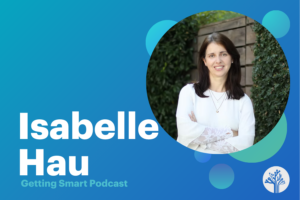15 Actionable Strategies for Increasing Student Motivation and Engagement

By Terri Eichholz
This blog originally ran on FusionYearbooks.com.
For a more recent post on student agency and engagement, click here.
In his book, Drive: The Surprising Truth About What Motivates Us, Daniel Pink argues that extrinsic motivations such as grades, standardized tests and financial rewards are merely temporary incentives that cannot provide a sustainable framework for quality learning and careers.
The question then is how can we educators encourage our future world citizens to develop their own determination to learn and succeed? Although it seems paradoxical to us to extrinsically motivate our students to intrinsically motivate themselves, there are five main areas in which we can help to create an environment that will offer the perfect conditions for intrinsic motivation to develop.
Establish relationships with students and build on their strengths
According to Robert Marzano, “Positive relationships between teachers and students are among the most commonly cited variables associated with effective instruction. If the relationship is strong, instructional strategies seem to be more effective.” Here are some great ways to gain the trust of your students and learn what is meaningful to them.
1. Give students an opportunity to show what they value most.
In the art project pictured right, students cut out silhouettes of themselves and then decorate them with symbols to represent their interests and important experiences. This is a fun way to start your school year, and can give you useful insights into the lives of your students. Consider doing one yourself, so they can learn about you, too!
2. Make better decisions by collecting clear data on your students.
By collecting data digitally, you can instantly refer to it throughout the year when making decisions about class projects and assessments, allowing you to build on the strengths and interests of individual students. Thrively is a great online tool that will provide a detailed picture of each student’s interests and skills.
3. Ask students what they expect from you and make sure you meet their expectations.
When students feel that you have a genuine interest in what you can do to gain their respect, they will be more willing to do what they can to gain yours. Asking for their opinions about what constitutes a good teacher in their eyes, and doing your best to live up to their descriptions, will show students that what they say matters to you.
Give the students choices whenever possible
Many educators, such as teacher and author Larry Ferlazzo, agree with Daniel Pink that a sense of autonomy is a major factor in intrinsic motivation. Though there are many requirements for teachers regarding the required skills for each level, we do, generally, have autonomy over the way we can teach and assess these skills. This is where we have the opportunity to offer some choices to the students. We can:
4. Let students choose what they want to learn.
“Genius Hour” (also called, “20% Time” or “Passion Time”) has become a huge trend in education. Originally based on a concept used in some famous companies such as Google and Federal Express where workers were given time during their work week to pursue their own creative projects, teachers around the world have developed ways to include this in their own school schedules. One of the most popular pages on my website, Engage Their Minds, is the Genius Hour Resources page, which offers examples and resources on how to facilitate Genius Hour in your own classroom.
5. Give students options for how they want to learn something.
Perhaps you don’t have the freedom to allow students to choose their own learning topics. That doesn’t mean they can’t still have choices. You can give students their own options for how to achieve their learning objectives. Many teachers offer their students “Choice Boards,” allowing them to tailor their own learning activities to individual preferences. This example of an art history choice board for primary students provides learning styles options to help students make their decisions.
6. Let students choose their own assessments.
We know that we need evidence of learning from our students so we can report this to their parents and the school. However, assessments can come in many forms. Choice boards can be used to suggest ways to demonstrate learning, just as they are used to present a variety of learning activities. A great digital tool for product suggestions is “The Differentiator,” which was adapted from David Chung and The Flip Book, Too by Sandra N. Kaplan, Bette Gould & Victoria Siegel by Ian Byrd, a gifted educator and author of Byrdseed.com.
Whenever you can’t give students choices, find ways to make it relevant
This is where the interest inventories and other relationship-building activities will become useful. Students need to see connections between what they are learning and their own lives in order to feel compelled to exert effort. How many times have we heard, “When are we going to use this?” from our students (or said it ourselves)? If we can show how our lessons apply to our students’ lives, their engagement will be stronger–and, of course, that leads to greater motivation! Try some of these ideas to make real-world connections.
7. Leverage social media.
Teenagers love Instagram. So, why not use Instagram to find out what your students know about Steinbeck’s Of Mice and Men? That’s what Laura Randazzo did in this assignment. She learned that this method increased engagement and included the added bonus that the students loved teaching her the nuances of Instagram.
8. Create authentic learning experiences instead of abstract challenges.
Like Nathan Lang, who tweeted the image below, many educators have found value in using authentic problems as a foundation for learning. In this example from Education World, second grade students use problem-solving, collaboration and research to help a classmate get a much-needed bed to sleep in. This article from CNN has a section on Project Based Learning, and cites how a fender bender in the school parking lot became a springboard for a class project
9. Integrate pop culture into your lessons using song lyrics, memes and clips from movies and television shows.
Teach Arguments with Pop Culture uses commercials to motivate students to learn more about rhetoric. Mr. Wasko gives students examples from videos and music to teach about figurative language. Students will be much more motivated to access the History for Music Lovers Youtube channel which features a plethora of history lessons sung to the tune of popular songs such as Lady Gaga’s “Bad Romance” to learn about the French Revolution instead of watching a dry PowerPoint presentation on the topic.
Model goal-setting and goal-tracking
When students are intrinsically motivated, they are not concerned about receiving the highest grade in the class or winning a trophy for their accomplishments. They care more about measuring their own learning and progress and less about comparing themselves to others. Here are some ways you can help them to monitor goals and achievements:
10. Publicize goals to help students to stay accountable.
If you’ve ever made a New Year’s resolution, then you know that keeping it a secret makes it easier to give it up. Making goals visible to others makes your commitment more binding. Students are more likely to reflect on their goals when they know that others are aware of them and will know if and when success has been achieved.
12. Give opportunities to reflect on those goals.
Goals are meaningless if you don’t regularly track your progress and think about what can help you to achieve them. Use reflection sheets like the one below on a daily or weekly basis to encourage students to consider the actions they’ve taken toward accomplishing their goals. My favorite part of the example below is the word, “yet.” This small word can make a big difference in student effort!
Offer Consistent and Constructive Feedback
One of my college professors used to underline my entire assignments as he read them, then write a “B” at the top of the papers–with no explanation. As you can imagine, this information was meaningless to me, and gave me no opportunity for growth. Frequent and thoughtful feedback will increase the intrinsic motivation to learn in students as they realize their hard work has value and their instructor is genuinely interested in providing support.
13. Give effective and objective feedback.
Mark Barnes’ SE2R Feedback model provides an alternative to using subjective grades and their averages for assessment, which often don’t give a true picture of student learning. With SE2R, students receive objective feedback regularly that gives them opportunities for improvement and higher learning. You can learn more about Mark’s solutions for assessment in his book, Assessment 3.0: Throw Out Your Grade Book and Inspire Learning.
14. Give meaningful praise that will help students to know what they are doing right.
“You are smart,” can actually decrease motivation in the long-run, as children who receive this kind of praise become reluctant to try anything that might disabuse people of the notion that they are intelligent. The graphic below offers some alternatives that can help your students to identify what they are doing well so they will be sure to do it again. Read this article by Carol Dweck, a Stanford University psychology professor, on how to best use praise effectively.
15. Give timely feedback.
If you have ever used a fitness tracker like the Fitbit, then you know the importance of receiving feedback throughout your activities–not just at the end when it’s too late to improve. By frequently administering formative assessments such as comments in Google Docs, or using student response options like Plickers, Kahoot or Socrative to get a better sense of the level of learning, teachers and students can make improvements that will maximize the potential for learning.
In a world that relies too often on extrinsic motivators to encourage and measure success, it can be a challenge to forgo these for the sake of helping our students to build a stronger foundation that will not disintegrate the moment the “carrot and the stick” disappear. It is our duty as educators, however, to dissuade our students from continuously searching for immediate gratification.
As we show our students that they can trust us to care about what is important to them and to work in their best interests, they will gradually learn the value of learning for their own sakes. They will find it is much more fulfilling to drive themselves than to have others drive them.
For more, see:
- Three Toolkits To Help Maximize Student Learning & Engagement
- 3 Key Ways to Inspire Student Engagement and Motivation
- 6 Best Practices for Online Student Engagement
Terri Eichholz teaches gifted students in kindergarten through 5th grades in San Antonio, TX. Follow her on Twitter: @terrieichholz.






c carrie gray
Very good article . . . however: 10. Publicize goals to help students to stay accountable "jumps" to 12. Give opportunities to reflect on those goals. Could you respond with the missing "11"? Thanks ~ CC
Replies
Catherine Wedgwood
Hi CC - Good catch! Thanks so much for letting us know that was missing--it has been fixed. Thanks for reading!
neeraj karshi
very nice <3
Aadhya
Thank you for providing such valuable details at a comprehensive level and evaluating the interests and skills of each student and a great opportunity for students to present a variety of learning activities that lead to greater motivation to achieve their goals.
Shannon Colclough
I like the fact that you said incorporate children in the learning process and let them choose what they want to learn. For example, we can do a science project on rain water but let choose which science project to choose from when learning about the whole water precipitation process.
Steven H Slough
This article reminds us that we learn best when we feel that we are included in the process of learning.